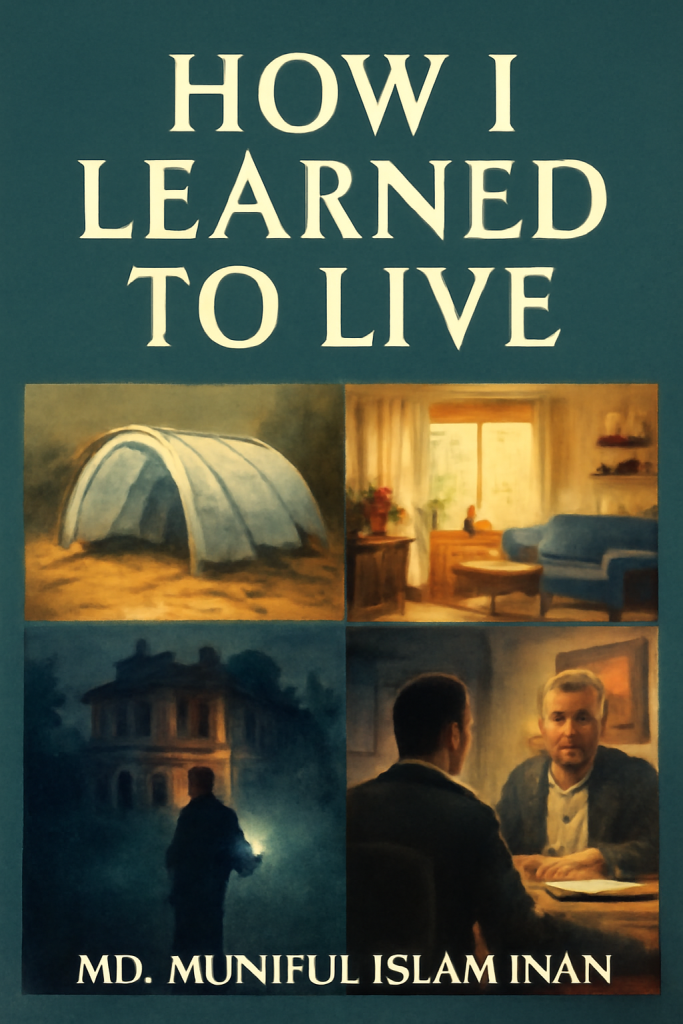
How I Learned to Live
Chapter One: The World I Built
There wasn’t much left for me to hold onto anymore.
The world I knew — the one filled with noise, expectations, failures, and invisible wounds — had become too heavy for my tired hands.
So I walked away.
Far, far from everything I once knew, I found a lonely piece of land where no one would come looking for me.
No roads. No voices. No promises.
There, with nothing but a few polytubes and scraps of forgotten material, I began building a world of my own.
It wasn’t beautiful in the way cities are beautiful.
It wasn’t safe in the way homes are safe.
But it was mine.
And for the first time in a long time, that was enough.
I built small shelters from the polytubes—hollow bones of a new life.
I tied them with worn ropes, bent them with tired hands, shaped them under the naked sky.
When the wind howled, my little polytube walls shivered, but they didn’t fall.
Just like me.
I called it my “First Home.”
Not because it was made well, but because it was the first thing I had built with my own broken heart — not for anyone else’s approval, but for my own survival.
The days passed slowly, folding into each other like soft waves.
There were no clocks.
No demands.
Just the breath of the wind, the soft creak of the tubes, and the echo of my own heart slowly learning how to beat again.
I didn’t know it then.
But somewhere in that fragile world of polytubes and broken dreams,
I was planting the first seeds of a life I had never dared to believe I deserved.
A life where living itself would become a miracle.
Chapter Two: The Home I Made My Own
After living wrapped in silence for what felt like lifetimes,
I realized I needed something more than just solitude.
I needed a place that didn’t just keep me breathing —
I needed a place that made me feel alive again.
I found it in a corner of Dhaka city — tucked quietly inside the old military zones of Cantonment, near ECB Chattar.
Among the rush of autos, the distant echo of traffic, the call to prayer rising from nearby mosques — there, hidden between life and noise, I rented a small apartment.
The building was tired, like me.
The windows had dust, the tiles had cracks,
but when I stepped inside, something whispered:
“Here, you can heal.”
I rented it with trembling hands.
It was not big, but it had enough — a living room where light poured in, a tiny kitchen where I could boil tea, a soft balcony that looked down onto the breathing city.
It became my first step toward reclaiming myself.
I decorated it with softness in mind.
Pale curtains to calm the sun.
A small prayer mat by the window, where the morning light could fall on my hands as I whispered to Allah.
Simple books on a low shelf.
Two or three plants on the balcony railing, their green leaves dancing with the dusty Dhaka air.
Every little thing was a quiet promise to myself:
“You are building your life again. Brick by invisible brick.”
And somehow… the city’s noise no longer frightened me.
It became like a river, flowing outside my window, while inside my small world, peace slowly started to grow.
I would sit by the window at sunset —
the sky over Dhaka painted with pinks and oranges —
and for a few stolen moments,
I didn’t feel broken.
I didn’t feel lost.
I just felt… here.
Alive.
Breathing.
And in those moments, a voice inside me whispered for the first time in a long time:
“Maybe… just maybe… life can be beautiful again.”
Chapter Three: The Words I Chose to Carry Me
The more I wrote, the more I realized:
life itself was full of hidden stories — waiting for someone brave enough to listen.
One night, sitting by my window with the city lights flickering far below,
I decided to chase one of those hidden stories.
Not just to earn,
but to prove something to myself:
that I could step into fear and walk out stronger.
I had heard rumors about a haunted house near the edges of old Dhaka —
a place people crossed the street to avoid after sunset.
The house was an old colonial relic, buried behind wild trees, rusted gates, and broken windows that looked like tired eyes.
Locals said strange noises came from there.
Whispers.
Footsteps.
Lights flickering in empty halls.
Some said they saw shadows moving inside,
others said the house itself “held its breath” — waiting for someone.
I packed a small notebook, a torch, and my worn camera.
This was going to be my first real investigation — not just to scare myself, but to tell a story hidden under fear.
As I stepped through the creaking gate, the air grew colder.
The street noise faded behind me like a distant memory.
Every step toward the house felt heavier, as if unseen hands were pressing against me, asking me to turn back.
But I didn’t.
I had come too far, both outside and inside myself.
Inside the house, the floorboards moaned under my feet.
Dust floated like silent ghosts in the beam of my torch.
I walked through empty rooms, walls covered in peeling paint,
mirrors cracked like spiderwebs.